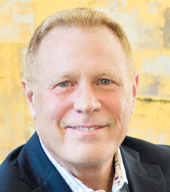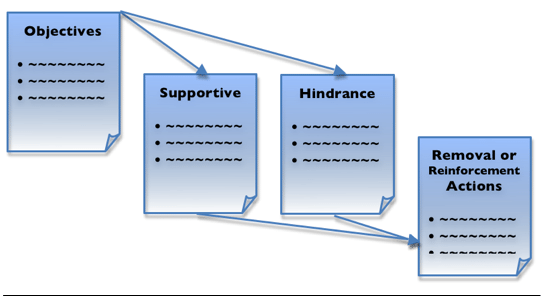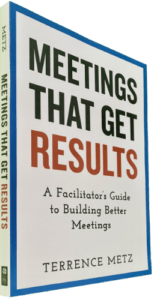Force Field analysis modifies and improves upon a similar approach called “pros & cons.” Force Field analysis helps groups identify and prioritize actions and opportunities for improvement, especially among product and project teams.
This approach to Force Field analysis makes it easier for groups to organize their thinking while encouraging thoughtful exploration. Once supportive and hindering forces are identified, the group analyzes the impact, leading to actions that reinforce the positive and mitigate the negative forces.
Procedure to Facilitate Force Field Analysis
Force field analysis begins by identifying the objectives, or CTQs (Critical to Quality), or targets. First, facilitate clear understanding of WHAT needs to change. Next, for each discrete objective (typically built in advance of a meeting or workshop and provided in a pre-read as a slide or handout), ask the following questions, ONE AT A TIME:
- What is hindering us from reaching this target (negative, or forces hindering change)?
- Environmental Forces
- Structural/ Organizational Forces
- Technological Forces
- Individual Forces
- What is helping us move toward this target (positive, or forces supporting change)?
- Environmental Forces
- Structural/ Organizational Forces
- Technological Forces
- Individual Forces
The responses will generate two new lists (ie, positive/ supporting and negative/ hindering forces). Adapt the Peter Senge philosophy that it is easier to remove obstacles (the hindrances) than to push harder (supportive forces). Focus discussion on what we can do differently to overcome the hindrances or obstacles. Facilitate the discussion on one obstacle at a time. For each obstacle, consider at least one action and perhaps more.
Once all actions have been clarified and understood, it may be necessary to prioritize them. When you have more than a one dozen actions, consider the Pareto Principle (ie, 80-20 Rule). If so, use MG RUSH’s PowerBall, Perceptual Mapping, or Decision-Matrix tools to facilitate consensual prioritization.
Notes about Force Field Analysis
See how the first list of objectives generates two lists (i.e., supports and hindrances) that lead to one consolidated action list, as shown in the diagram:
______
Don’t ruin your career by hosting bad meetings. Sign up for a workshop or send this to someone who should. MGRUSH workshops focus on meeting design and practice. Each person practices tools, methods, and activities daily during the week. Therefore, while some call this immersion, we call it the road to building high-value facilitation skills.
Our workshops also provide a superb way to earn up to 40 SEUs from the Scrum Alliance, 40 CDUs from IIBA, 40 Continuous Learning Points (CLPs) based on Federal Acquisition Certification Continuous Professional Learning Requirements using Training and Education activities, 40 Professional Development Units (PDUs) from SAVE International, as well as 4.0 CEUs for other professions. (See workshop and Reference Manual descriptions for details.)
Want a free 10-minute break timer? Sign up for our once-monthly newsletter HERE and receive a free timer along with four other of our favorite facilitation tools.

Terrence Metz, president of MG RUSH Facilitation Training, was just 22-years-old and working as a Sales Engineer at Honeywell when he recognized a widespread problem—most meetings were ineffective and poorly led, wasting both time and company resources. However, he also observed meetings that worked. What set them apart? A well-prepared leader who structured the session to ensure participants contributed meaningfully and achieved clear outcomes.
Throughout his career, Metz, who earned an MBA from Kellogg (Northwestern University) experienced and also trained in various facilitation techniques. In 2004, he purchased MG RUSH where he shifted his focus toward improving established meeting designs and building a curriculum that would teach others how to lead, facilitate, and structure meetings that drive results. His expertise in training world-class facilitators led to the 2020 publication of Meetings That Get Results: A Guide to Building Better Meetings, a comprehensive resource on effectively building consensus.
Grounded in the principle that “nobody is smarter than everybody,” the book details the why, what, and how of building consensus when making decisions, planning, and solving problems. Along with a Participant’s Guide and supplemental workshops, it supports learning from foundational awareness to professional certification.
Metz’s first book, Change or Die: A Business Process Improvement Manual, tackled the challenges of process optimization. His upcoming book, Catalyst: Facilitating Innovation, focuses on meetings and workshops that don’t simply end when time runs out but conclude with actionable next steps and clear assignments—ensuring progress beyond discussions and ideas.




